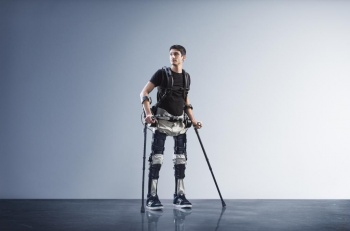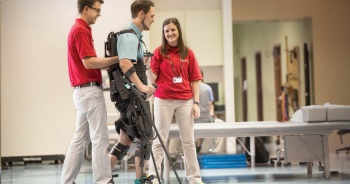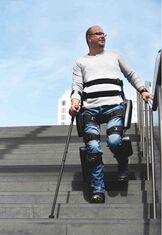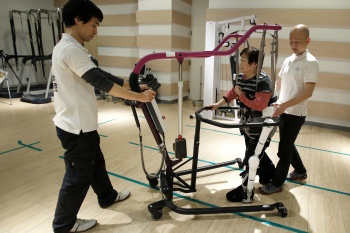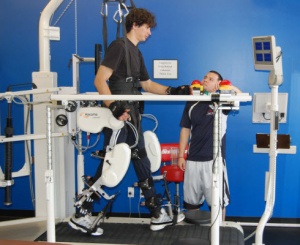Robotic Rehabilitation for the Lower Extremity
Original Editor - Steven Hua, Brandon Graham, Sebastian Wozniak, Eric Beech
Top Contributors - Steven Hua, Angeliki Chorti, Kim Jackson, Sebastian Wozniak, Dennis Riley Louie, Brandon Graham, Naomi O'Reilly, Eric Palmer Beech, Rishika Babburu, 127.0.0.1, Rachael Lowe and Amrita Patro
Introduction/Overview[edit | edit source]
Advancing exoskeleton robotic technology presents an opportunity for physiotherapists and rehabilitation. Robotic technology is suggested to have extensive application prospects in rehabilitation, and professional requirements in this field are high [1]. Global exoskeleton market is anticipated to reach a significant size of 3.340 billion USD, expanding at a growth rate of 46.2% by 2026 [2].
An important part of robotic technology research is involved with lower extremity rehabilitation. People with lower extremity disorders leading to problems in gait are increasing rapidly in contemporary aging societies, but availability of specialised rehabilitation personnel and equipment does not currently match these requirements [1]. Gait improvement is both a desirable and important outcome for social and vocational reintegration [3] .
Target population[edit | edit source]
Use of robotics in rehabilitation can benefit many patient populations, including:
| [6] |
- Cerebral Palsy [7]
- Parkinsons [8]
- Multiple Sclerosis (MS) [9]
- Traumatic Brain Injury [10]
- Elderly care [11]
- Post-surgery [12]
- Orthopaedics [12]
Advantages[edit | edit source]
Lower extremity rehabilitation, especially for gait recovery, can require significant time and physical effort on the part of physiotherapists. Not only is this an expensive and subsequently unrealistic approach for rehab, it is also extremely labour intensive for the therapists to provide this care. However, gait is one of the most important aspects of lower limb robotic rehabilitation. With current methods of improving gait, multiple therapists are necessary to help the patient move each joint and leg appropriately to get the greatest benefit.
Robotic devices designed for lower extremity rehabilitation, powered orthoses with computer-controlled motors to support joint movement[13], can increase the therapeutic dose of movement training while potentially offloading therapists' burden. With the use of robotics, less therapist attention is required to deliver the same mechanical therapy. With the patient strapped into the robotic device, the therapist will only need to provide supervision and the setting up of the device. [14] This may help teach the patient proper technique with walking right from the beginning, thus avoiding improper gait patterns.
In addition to increasing repetition of specific movements (e.g., gait cycles), some other ways in which robotics may be of therapeutic benefit are:
- monitoring and controlling movement parameters (i.e., speed, direction, amplitude, sequencing) in real time;
- providing sensory feedback during movement[15];
- providing a safe environment for controlled perturbations;
- providing weight support with minimal exertion;
- and offering the potential for objective measurements in terms of more reliable, standardised tests and goniometry measures[13] for patient progress and treatment planning [16].
Another way robotics can help patients is through improvements in range of motion (ROM) through the reduction of joint impedance. The components of joint impedance, such as passive and reflexive resistance can determine how the joint restriction is occurring. Robotics can then use precise amounts of velocity and amplitude to apply to the patient based on their individual needs. This may help improve ROM using precise forces applied at specific times. The use of continuous passive motion machines are common in rehab to improve joint ROM. However, with more state-of-the-art machines, ROM improvements can, theoretically, be gained at a quicker rate while ensuring patient comfort and safety[16].
Robotics can also be used in improving and determining a patient’s proprioception of their lower limbs. Once the patient’s eyes are closed, the machine can be set up to move a patient’s limb into a position. The patient is then asked to think about the limb’s position and match it to that of the machine. This helps the patient to focus on the positioning of the limb and place the opposing limb in a similar position. The detection of minor passive movement with a limb can also be tested with robotics. Again with the patient’s eyes closed, the strapped-in limb is moved slowly and gradually with the robotics. The patient speaks out once he/she feels the limb has begun to move. This will determine how much movement is required for the patient to feel. Not only can this be used for a sign of treatment but also for a precise assessment tool.
While these are only some of the advantages of robotic therapy for lower limb rehabilitation, the robotics industry is a growing field that has many opportunities to improve patient care. With time and research, implications for the robotics industry on lower limb rehabilitation will continue to develop.
For information regarding the use of robotics for the upper extremity, go to the Upper Extremity Rehabilitation using Robotics Physiopedia page.
Other Health Outcomes[edit | edit source]
Long-term use of lower extremity robotics can lead to [13]:
- Increased strength in lower-extremity
- Improved posture
- Increase in bone density
- Improved bowel movements
- Improved sleep
- Decreased pain
- Decreased cholesterol
- Decreased spasticity
- Decreased rate of cardiovascular disease
- Decreased rate of diabetes
Psychological Considerations[edit | edit source]
Motivation and engagement are immensely important to a patient's success and positive outcomes when it comes to the incorporation of technology within therapy. A positive introduction to the robotic device will promote sustained use, whereas a negative experience may lead to decreased motivation and a reduced effect of utilising the device on therapeutic outcomes [13]. The physiotherapist plays a large part in this regard, through providing proper instructions and feedback while the patient is learning to use the device.
To date, there are few studies that have investigated the effect of using robotic devices for lower extremity rehabilitation on patient mood or motivation. Some studies have found that patients have a positive view of incorporating robotic exoskeletons within rehabilitation [17] [18]. It is also important to consider therapists' acceptance and desire to use robotic technology within their practice, which depends on the learning curve to become familiar with operating the device and budding scientific evidence supporting physiotherapy outcomes [19].
Limitations and Challenges[edit | edit source]
As the potential benefits to using robotics for lower limb rehabilitation are apparent, there still are many challenges which need to be overcome and require further research. As of now the main limitations are high costs of acquiring and using robotic systems, lack of high clinical evidence for patient improvement, and the need for standardised measures for therapy protocol and assessment. Other limitations are their bulky size and lack of internal power supply duration with mobile units[14]. Patients who have spasticity can have it triggered by the robotic movement and the greater walking durations can lead to some adverse effects such as increased risk for fractures, abrasions, pressure sores and falls. [13] Specifically in regards to patients with heart conditions, being strapped into these machines can also be dangerous because, in the need for cardiac resuscitation or during other emergency situations, the patient is not accessible[20].
Robotic systems have the ability to take precise measurements of kinematic and dynamic values, which are far more reliable than those achieved with human error, and have the potential to be very useful for assessment purposes. This being said, there still remains a need to develop standardised procedures and protocols in order for this data to be useful. Currently, some examples of the data used from the robotics systems during assessments are ROM, walking distance, gait velocity and other various dynamic measures, but we do not yet have a standardised measure for assessment, like those seen in other gait related assessments (Barthel Index, Dynamic Gait Index, etc.). Furthermore, the effectiveness of robotics has not been shown to be highly superior to that of typical manually-assisted therapy provided by therapists and this is a driving reason as to why it has not yet been implemented into regular practice[14].
Examples of Current Robotics in Rehabilitation[edit | edit source]
There are already several lower extremity robotic devices that are commercially available, and many others that are being developed. Several examples of robotic devices for gait rehabilitation are shown below, which can be divided into different categories[21]:
- Power overground exoskeleton devices: Overground exoskeleton devices allow patients to ambulate without an overhead support system, though generally require patients to have some upper extremity strength to use an assistive device (e.g., forearm crutches) in collaboration with the device.
- Body weight-supported treadmill (BWST) exoskeleton devices or Driven Gait Orthoses (DGOs): BWST exoskeletons involve a harness that supports an adjusted percentage of a patient’s body weight, while robotic orthoses control hip, knee, and/or ankle movement patterns during gait. Initial stages of rehabilitation may require the manual assistance of two therapists.
- End-effector devices: End-effector devices also provide some body weight support with the use of a harness, but instead of orthoses they generally strap the patient’s feet and ankles onto foot-plates that mimic the trajectory of gait[22].
Overground Exoskeletons[edit | edit source]
Phoenix[edit | edit source]
Phoenix is a 23 lbs exoskeleton that has motors that control hip and knee movements. Its average walking speed is 1.1 miles/hour, and its battery life allows for approximately 4 hours of continuous walking. It is meant for use in the clinic and community[23].
Ekso GT[edit | edit source]
It is designed to be used in the clinic with the supervision and guidance of a physical therapist for SCI (C7 and below) or stroke[25].
| [26] |
Rewalk[edit | edit source]
Rewalk has 2 Models: A rehab model for use in clinics and a personal model for ambulating in the community.
It’s mainly used for SCI patients with T7 to L5 SCI, as upper extremity strength is required. It is available in USA and Europe. The European model includes ascending and descending stairs functions. [28]
Rex[edit | edit source]
Rex is designed for in clinic use, and can help patients who weigh up to 100kg. It supports/stabilises the torso with abdominal straps and padding, hence less core activation is required by the patient http://www.rexbionics.com/product-information/. [29]
The Keeogo[edit | edit source]
The Keeogo is another exoskeleton that allows for flat-ground ambulation, as well as helping to ascend and descend stairs. It’s available in Canada for purchase and rental and is designed for patients who have the ability to independently ambulate with at least an assistive device[30].
Hybrid Assistive Limb (HAL)[edit | edit source]
HAL is a light-weight power assistive device which uses a technology that senses electrical signals sent from brain to the muscles (through surface electromyography and ground reaction force sensors) and initiates the required movement for the patient. [21]
HAL are especially useful in early gait rehabilitation to establish stronger brain-muscle connections. If no signals are detected (e.g. paraplegia) then the robot has an automated gait pattern that it puts the person through. There are different versions of HAL depending on the use (full body, lower body, one legged) [21]
Indego[edit | edit source]
Indego is a 26 lbs exoskeleton that offers functional electrical stimulation (FES) to the lower extremity muscles. It’s designed for clinic and community ambulation[32].
BWSTT Exoskeletons[edit | edit source]
Lokomat[edit | edit source]
Lokomat is the most popular BWSTT exoskeleton, and it’s been used for over 280 gait rehabilitation studies with various patient populations[33].
End-Effector Devices[edit | edit source]
The Gait-Trainer GT 1[edit | edit source]
The Gait-trainer GT 1 provides FES to up to 8 muscle groups. Instead of orthoses, patient’s feet are strapped to footplates whose trajectories mimic on ground walking. This provides increased freedom of movement for the knees and hips[35].
G-EO System[edit | edit source]
G-EO System doesn’t provide FES, but it does provide additional footplate trajectories that mimic stair-climbing[36].
Lokohelp[edit | edit source]
Lokohelp is similar to the G-EO system, but provides no stair climbing option[37].
Future of Robotics[edit | edit source]
As rehabilitation robotics advances, it has the potential to completely change the way that physiotherapists deliver treatment to patients. The ultimate goal is for physiotherapists to be able to use robotics to benefit their practice by increasing the effectiveness of their assessment and treatment. Since demand for physiotherapists and long-term rehabilitation is rising, one of the main goals of current robotic development is to pair information technology with rehabilitation robotics to deliver assessment and treatment over the internet so that the physiotherapist can supervise the treatment in the comfort of the patient’s own home and allow one physiotherapist to see a large number of patients simultaneously[38].
Currently, present-day gait robotics cannot generate the power and force necessary for running and jumping rehabilitation. In the future, development in this area will be beneficial to athletes rehabilitating from a spinal cord injury[13]. Batteries are also being further developed to maximise its life, size, weight, and ease to recharge[13]. Other areas of robotic technology that are currently being focused on include developing lighter weight technology, making devices accessible off-the-counter and combining virtual reality and video games to maximise patient motivation[13].
References[edit | edit source]
- ↑ 1.0 1.1 Shi D., Zhang W., Zhang W., Ding X. A review on lower limb rehabilitation exoskeleton robots. Chinese J Mechanical Engineering 2019; 32; 74.
- ↑ MarketsandMarkets.Exoskeleton Market by Type (Powered, Passive), Component (Hardware, Software), Mobility, Body Part (Lower Extremities, Upper Extremities, Full Body), Vertical (Healthcare, Defense, Industrial) and Region (2021-2026).Available online: https://www.marketsandmarkets.com/Market-Reports/exoskeleton-market-40697797.html?gclid=EAIaIQobChMI0sb4vu_6-AIVuY1oCR0KRguCEAAYASAAEgJQu_D_BwE [accessed 15/07/2022]
- ↑ Esquenazi A., Talaty M. Robotics for Lower Limb Rehabilitation. Phys Med Rehabil Clin N Am. 2019 May;30(2):385-397.
- ↑ Edwards, D., Forrest, G., Cortes, M. Weightman M., Sadowsky C., Chang S-H., et al. Walking improvement in chronic incomplete spinal cord injury with exoskeleton robotic training (WISE): a randomized controlled trial. Spinal Cord 2022; 60: 522–532.
- ↑ Hobbs B., Artemiadis P. A Review of Robot-Assisted Lower-Limb Stroke Therapy: Unexplored Paths and Future Directions in Gait Rehabilitation. Frontiers in Neurorobotics 2020; 14:19.
- ↑ Sandro Gatillo. Robotics Technology for Stroke and Brain Injury Rehabilitation [Internet]. 2017 [cited 8 May 2017]. Available from: https://www.youtube.com/watch?v=-EdfmoVBR5k
- ↑ Bayon C., Raya R., Lerma Lara S., Ramirez O., Serrano I., Rocon E. Robotic therapies for children with cerebral palsy:a systematic review. Translational Biomedicine 2016; 7(1):44.
- ↑ Capecci, m., Pournajaf S., Galafate D., Sale P., Le Pera D., Goffredo M., De Pandis MF., Andrenelli E., Pennacchioni M., Ceravolo MG., Franceschini M. Clinical effects of robot-assisted gait training and treadmill training for Parkinson's disease. A randomized controlled trial. Annals Phys and Rehabil Med, 2019; 62(5):303-312.
- ↑ Sconza C., Negrini F., Di Matteo B., Borboni A., Boccia G., Petrikonis I., Stankevičius E., Casale R. Robot-Assisted Gait Training in Patients with Multiple Sclerosis: A Randomized Controlled Crossover Trial. Medicina (Kaunas) 2021; 57(7):713.
- ↑ Karunakaran K., Nisenson D., Nolan K. Alterations in Cortical Activity due to Robotic Gait Training in Traumatic Brain Injury. Annu Int Conf IEEE Eng Med Biol Soc. 2020 Jul;2020:3224-3227.
- ↑ Pearce A., Adair B., Miller K., Ozanne E., Said C., Santamaria N., Morris M. Robotics to Enable Older Adults to Remain Living at Home. J Aging Res 2012; 2012: 538169.
- ↑ 12.0 12.1 Payedimarri A., Ratti M., Rescinito R., Vanhaecht K., Panella M. Effectiveness of Platform-Based Robot-Assisted Rehabilitation for Musculoskeletal or Neurologic Injuries: A Systematic Review. Bioengineering 2022, 9(4), 129.
- ↑ 13.0 13.1 13.2 13.3 13.4 13.5 13.6 13.7 Bryce T, Dijkers M, Kozlowski A. Framework for Assessment of the Usability of Lower-Extremity Robotic Exoskeletal Orthoses. Am J Phys Med Rehabil. 2015;94(11):1000-1014. DOI:10.1097/PHM.0000000000000321
- ↑ 14.0 14.1 14.2 Díaz I, Gil J, Sánchez E. Lower-Limb Robotic Rehabilitation: Literature Review and Challenges. J Robotics. 2011;2011:1-11.
- ↑ Molteni F, Gasperini G, Cannaviello G, Guanziroli E. Exoskeleton and end-effector robots for upper and lower limbs rehabilitation: narrative review. PM R. 2018;10:S174-S188.
- ↑ 16.0 16.1 Maggioni S, Melendez-Calderon A, van Asseldonk E, Klamroth-Marganska V, Lünenburger L, Riener R et al. Robot-aided assessment of lower extremity functions: a review. J Neuroeng Rehab. 2016;13(1).
- ↑ Manns P.J., Hurd C., Yang JF. Perspectives of people with spinal cord injury learning to walk using a powered exoskeleton. J Neuroeng Rehabil. 2019;16:94.
- ↑ Postol N., Grissell j., McHugh C., Bivard A., Spratt N. , Marquez J. Effects of therapy with a free-standing robotic exoskeleton on motor function and other health indicators in people with severe mobility impairment due to chronic stroke: A quasi-controlled study. J Rehabil Assist Technol Eng. 2021 Jan-Dec; 8: 20556683211045837.
- ↑ Mortenson WB, Pysklywec A, Chau L, Prescott M, Townson A. Therapists' experience of training and implementing an exoskeleton in a rehabilitation centre. Disabil Rehabil. 2020. https://doi.org/10.1080/09638288.2020.1789765
- ↑ Harwin W, Patton J, Edgerton V. Challenges and Opportunities for Robot-Mediated Neurorehabilitation. Proc IEEE. 2006;94(9):1717-1726.
- ↑ 21.0 21.1 21.2 Ramesh N., Iwaniec M., Arawade S. Past, present and future of assistive robotic lower limb exoskeletons. MATEC Web of Conferences 2022; 357:03005.
- ↑ Mehrholz J, Pohl M. Electromechanical-assisted gait training after stroke: A systematic review comparing end-effector and exoskeleton devices. Journal of Rehabil Med. 2012;44(3):193-199.
- ↑ Phoenix | suitX [Internet]. Suitx.com. 2017 [cited 9 May 2017]. Available from: http://www.suitx.com/phoenix
- ↑ suitX. Phoenix [Internet]. 2017 [cited 8 May 2017]. Available from: http://www.suitx.com/phoenix
- ↑ Products | Ekso Bionics [Internet]. Ekso Bionics. 2017 [cited 9 May 2017]. Available from: http://eksobionics.com/eksohealth/products/
- ↑ Business Street. Community Regional Medical Center Demonstrates Esko Bionic Exoskeleton [Internet]. 2014 [cited 8 May 2017]. Available from: https://www.youtube.com/watch?v=fav-sgk7_yA
- ↑ Madonna Rehabilitation Hospitals. Ekso GT Robotic Exoskeleton [Internet]. 2017 [cited 8 May 2017]. Available from:https://www.madonna.org/images/uploads-users/content/gallery/Ekso_1200x630_2 .jpg
- ↑ Comparing Indego vs Ekso GT vs ReWalk, Researched by VAPAHCS [Internet]. Exoskeleton Report. 2017 [cited 9 May 2017]. Available from: http://exoskeletonreport.com/2016/09/comparing-indego-vs-ekso-gt-vs-rewalk-researched-vapahcs/
- ↑ Product Information - Rex Bionics [Internet]. Rex Bionics. 2017 [cited 9 May 2017]. Available from: http://www.rexbionics.com/product-information/
- ↑ Who is Keeogo™ for? [Internet]. Keeogo restores and enhances autonomy in mobility. [cited 2017May9]. Available from: http://www.keeogo.com/who-is-keeogo-for
- ↑ Spinal Cord Research and Advocacy. Lower Limb HAL [Internet]. 2015 [cited 8 May 2017]. Available from: https://spinalcordresearchandadvocacy.files.wordpress.com/2015/09/lower-limb-hal .jpg
- ↑ Indego – Powering People Forward | Parker Indego [Internet]. Indego.com. 2017 [cited 9 May 2017]. Available from: http://www.indego.com/indego/en/home
- ↑ Lokomat® - Hocoma [Internet]. Hocoma. 2017 [cited 9 May 2017]. Available from: https://www.hocoma.com/solutions/lokomat/
- ↑ Center For Neuro Recovery. Lokomat Pro Gait Training [Internet]. 2015 [cited 8 May 2017]. Available from: http://www.centerforneurorecovery.com/wp-content/uploads/2015/06/Lokomat-Pro-Robotic-Gait-Training .jpg
- ↑ Reha Stim | Gait Trainer GT I [Internet]. Reha-stim.de. 2017 [cited 9 May 2017]. Available from: http://www.reha-stim.de/cms/index.php?id=76
- ↑ G-EO System - Reha Technology [Internet]. Rehatechnology.com. 2017 [cited 9 May 2017]. Available from: https://www.rehatechnology.com/en/products/g-eo-system
- ↑ LokoHelp | Woodway [Internet]. Woodway.com. 2017 [cited 9 May 2017]. Available from: https://www.woodway.com/products/lokohelp
- ↑ Laut J , Porfiri M & Raghavan P. The present and future of robotic technology in rehabilitation. Curr Phys Med Rehabil Rep. 2016;4: 312.
